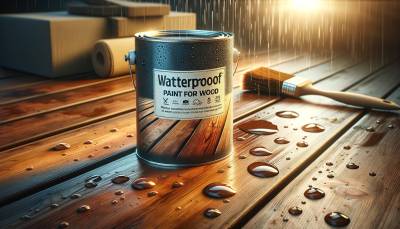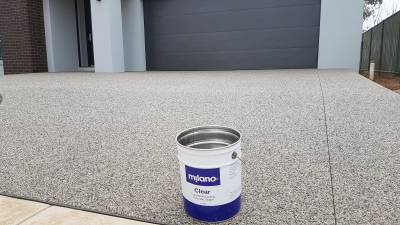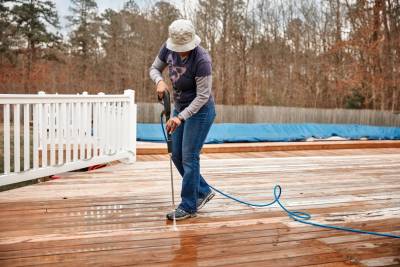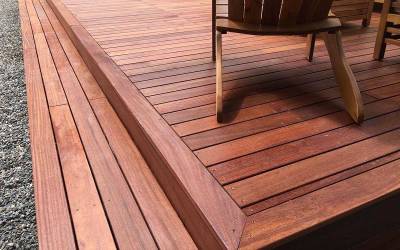Unlocking the Beauty of Your Outdoor Space with White Wood Stain
By Thomas


Share —
Revamping or creating a piece of wooden furniture can be a fulfilling and fun project. Perhaps you've found an old, worn-out piece with the perfect shape and structure, or maybe you've crafted a brand new piece yourself. Either way, the finishing touch of your project might include giving it a clean, modern, and fresh finish with white wood stain.
Understanding White Wood Stain and its Application
The process of staining wood can do more than just changing its color. It helps to protect the surface, enhance the wood's natural beauty, and add character to your furniture. White wood stain is a favorite choice among DIYers and professional woodworkers for its unique charm and elegance.
Reasons to Choose White Wood Stain
When it comes to decorating or refreshing your indoor or outdoor wooden furniture, white wood stain provides several benefits that other typical color stains might not offer, such as:
- Wonderful Aesthetic Appeal: White stained wood shows a combination of sophistication and simplicity, making it a perfect choice for a rustic or minimalist design theme.
- Versatility: White wood stain can blend easily with diverse color and décor themes while still allowing the natural wood grain to show through.
- Long-lasting: Modern white wood stains are engineered to resist fading and protect the wood surface against harmful UV rays, enhancing their durability.
Types of White Wood Stains
There are several types of white wood stain available in the market, each offering unique qualities.
White Oil-based Stain
White oil-based stains are ideal for interior wood projects like refinishing your kitchen cabinets. They provide a robust, long-lasting finish, but keep in mind that they have longer drying times compared to other types.
White Water-based Stain
White water-based stains are the perfect choice if you need a quick-drying solution. They’re also easy to clean up and produce fewer fumes, making them suitable for those who are conscious about the environment.
White Gel Stain
White gel stains are often chosen for their thickness and ease of control during application. They allow for a more consistent and even color, a desirable feature when working with porous or uneven surfaces.
Process of Applying White Wood Stain
Applying white wood stain involves a straightforward but detailed process, which requires careful execution.
- Clean the Surface: It is essential to start with a clean, dry surface. Remove old paint, wax, or previous stain before you start .
- Sanding: Sand the wood to get a smooth, ready-for-stain surface. It also helps open up the pores of the wood for better stain absorption.
- Apply Pre-Stain: A pre-stain wood conditioner will help your wood stain apply more evenly.
- Stain Application: Apply the white wood stain using a brush or a clean cloth. Pay attention to the direction of the wood grain during application.
- Let It Dry: Allow enough time for drying before applying additional coats. Always follow the manufacturer’s instructions for the best results.
- Seal: To protect the finish and enhance the overall appearance, add a clear wood sealant.
Top White Wood Stain Brands
There are numerous white wood stain brands in the market, with key players including Minwax, Varathane, and General Finishes, all offering a great quality product range.
Minwax
The Minwax Wood Finish is especially known for its penetrating oil-based wood stain, which has been a favorite product for more than 110 years. It provides beautiful rich color that enhances the natural wood grain.
Varathane
Varathane offers a variety of premium oil-based and water-based stains, and their white wood stains are praised for their excellent coverage, durability, and easy application.
General Finishes
General Finishes is well-known for its oil-based and water-based wood stains, including their popular white gel stain, perfect for use on furniture, cabinets, and more.
Whatever your next woodworking project maybe, using white wood stain is a fantastic way to create a distinctive and stylish finish. So choose the right type and brand of stain to give your furniture a refreshing, unique, and modern look with ease and precision. Be creative, and happy staining!
Frequently Asked Questions about White Wood Stain
How does white wood stain work?
White wood stain works in a similar fashion as other wood stains by penetrating into the wood to change its color, in this case, to a white shade. It enhances the appearance of the wood grain and adds texture and depth to your piece of furniture or wooden structure.
Can I use white wood stain on any type of wood?
Yes, you can use white wood stain on nearly any type of wood. However, the final result may vary depending on the type of wood. Hardwoods like oak and ash tend to absorb the stain more evenly, while softwoods like pine may show irregularities. Always test your stain on a hidden part of the wood first to ensure satisfying results.
What if the wood is already stained, can I apply white wood stain over it?
Applying white wood stain over an existing stain can be done, but it may affect the final color. The old stain could mix with the white stain, creating a different shade than initially planned. If possible, it is best to remove the old stain before applying the white wood stain.
How do I prepare my wood before applying white wood stain?
Preparing the wood is a crucial step before applying white wood stain. Start by sanding the wood to make the surface as smooth as possible. Then, remove any dust and dirt with a tack cloth or a damp rag. Make sure your wood is completely dry before applying the stain.
Is a second coat of white wood stain necessary?
Whether a second coat is necessary or not depends on the desired look. If you are happy with the coverage and color intensity after the first coat, then a second coat may not be necessary. However, if you want a more opaque white finish, a second or even third coat might be needed.
Do I need to seal the wood after staining?
Sealing your wooden project after staining it with white wood stain is recommended, especially if it's an outdoor piece. The sealer will protect both the stain and the wood, helping to prolong its lifespan and maintain its beauty.
Can white wood stain be used both for indoor and outdoor projects?
Yes, white wood stain can be used for both indoor and outdoor projects. However, for outdoor use, it's highly suggested to seal the white wood stain afterwards to protect it from sun and rain damage.
How long does it take for the white wood stain to dry?
Normally, white wood stain takes about 24 hours to dry completely, but this could vary depending on the brand of the stain, the temperature, and the humidity level. Always check the instructions on the product label for a more precise drying time.
Does white wood stain have a particular odor?
Most wood stains do come with a certain odor, including white wood stain. This is due to the solvents used in their formulation. The smell usually dissipates once the stain has fully dried. Using in a well-ventilated area is suggested during the application process.
Pros and Cons of White Wood Stain
Pros of White Wood Stain
Enhances Aesthetics
One of the top advantages of white wood stain is the way it enhances the overall appearance of the wood. It provides a subtle, elegant, and refreshing vibe that can drastically improve the visuals of your space. It is ideal for creating a light and airy ambiance, particularly complementing minimalistic, modern, and chic decor styles.
- The white wood stain allows the natural wood grain to show through, emphasizing the wood's natural beauty.
- White stain is versatile and suits a wide variety of decor styles and color schemes.
Offers Protection
Another significant benefit of white wood stain is that it offers a significant degree of protection to the wood. The sealing properties of the stain help prevent decay and damage, enhancing the longevity of the wood.
- White wood stain contains pigments and binders that protect the wood from harmful ultraviolet rays, reducing chances of discoloration and degradation over time.
- It also provides a defensive barrier against scratches and wear and tear, keeping your wood furniture and surfaces looking fresh and new for longer.
Easy Application
The application process of white wood stain is typically straightforward and easy to execute, even for someone without extensive DIY experience.
- No need for a primer as the stain directly sinks into the wood fibers.
- White stain levels out well, which helps to avoid streaks and blotches, resulting in a smooth, even finish.
Cons of White Wood Stain
Highlighted Imperfections
One of the drawbacks of using white wood stain is that it tends to highlight imperfections in the wood. Any scratches, dents, chips, or marks are more noticeable on a white surface as it lacks the ability to cover or camouflage these issues.
- The white color highlights any dust, dirt, and grime that accumulates over time, requiring more frequent cleaning.
- Discoloration from the tannins in the wood can show through the white stain, distorting the desired finish.
Maintenance Issues
White wood stain demands a higher maintenance regime as compared to utilizing darker stains or natural finishes. It can easily show dirt, marks, and stains, necessitating regular cleaning to keep the surfaces pristine and appealing.
- White wood surfaces can be challenging to keep clean, especially in high-traffic areas where touch and dust accumulation are frequent.
- If not properly sealed, white wood stain may not be as durable and might need regular reapplication to maintain its appearance.
Limitation in achieving an antique look
For those aiming to achieve an antique or rustic look, white wood stain may not be the best choice. The light, clean aesthetics of a white stain tend to align more with a contemporary or coastal style rather than an old-world charm.
- The bright, fresh look of white wood stain may not enable achieving an authentic distressed, vintage, or antiqued look.
- White stained wood may not exhibit the richness and depth associated with darker, natural wood stains.
Summary
Overall, white wood stain has proven to be a versatile accessory in any home improvement project. Its ability to highlight wood’s natural grain while giving it a refreshed, modern look makes it stand out from other types of stains. The allure of using white wood stain lies in its blending ability, effectively marrying the rustic appeal of wood with a sophisticated, updated finish.
White wood stain is not just about aesthetics but also about preserving and protecting your wooden pieces. It offers superior durability, guarding the surface of the wood from scratches, sunlight, and wear, therefore extending the lifespan of your furniture. There's a range of options available with different levels of opacity, so anyone can find the perfect fit for their unique needs and style preferences.
The use of white wood stain requires a bit of skill, but the result is always worth it. It's a simple way to bring a lighter and mood-enhancing feel to a room without losing the charm of the wood. So grab a can, and let the magic of white wood stain turn your home into a bright, stylish, and inviting living space.
About Grime Busters Pressure Washing
Welcome to Grime Busters Pressure Washing, a premier cleaning service provider based in Vancouver, WA. We are committed to delivering top-notch pressure washing services to both homes and businesses. Leveraging the power of high-grade equipment, an experienced team, and impact-friendly cleaning solutions, we strive to eliminate every speck of dirt and grime, restoring your property's natural beauty and freshness. For years, we've been shattering all notions of "tales of grime and horror", transforming them into stories of sparkling cleanliness, one pressure wash at a time.
Tags: wood stain, outdoor decor, home improvement,






